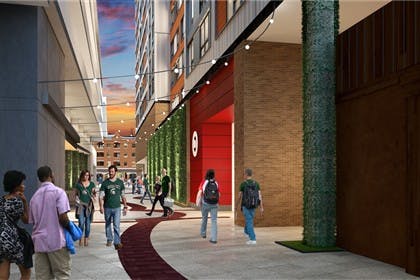Construction sites abound up and down Grand River Avenue, a new income tax was passed in part to fund infrastructure projects and there is the possibility of recreational marijuana on the horizon. East Lansing is consciously transitioning into an urban environment, and perhaps the most important part of that transition is housing.
The cornerstone of a successful and modern housing market for any city is diversity, according to Rayman Mohamed, Wayne State University’s graduate director of Urban Studies and Planning.
“Providing housing for people of different income levels, different socioeconomic backgrounds, is important for their own access to jobs within the city, and also for the city to have a pool of employees to fill those positions,” Mohamed said.
Diversity in this context means people of different economic means, ages, marital status, employment status and access to public amenities, he said.
This is particularly important for East Lansing, as college towns can suffer somewhat from homogeneous student housing that doesn’t incentivize long-term residency, said Tim Dempsey, East Lansing’s planning, building and development director.
Student-oriented housing also contributes to the “summer gap,” a phenomenon East Lansing is trying to mitigate.
“Michigan State has a lot of full-time students, so students leave during the summer, and I don’t know that it’s possible to fill these places over the summer,” Mohamed said. “If it is a strategy to attract other non-East Lansingers to come living in East Lansing even though they’re not part of the student body — so you can have a more sizable population during the summers — it makes sense to me, it seems like it’s worth exploring.”
The summer gap also affects businesses and investment in the area, and a more diverse population base would help prevent East Lansing from hemorrhaging residents over the summer who would otherwise support the local economy.
“There tends to be a time of year, from mid-May to mid-to-late August, where a lot of those units are empty,” Dempsey said. “When you don’t have other types of housing like owner-occupied — maybe people that are out of school and have full-time jobs and are earning more income — that’s an important demographic. It’s those types of people that help to attract higher-end restaurants and more diverse retail.”
If more people with differing income levels and backgrounds stay year-round, cities in general — not just East Lansing — are more stable, according to Gary Heidel, chief housing investment officer for the Michigan State Housing Development Authority.
The city government has begun taking steps to improve housing diversity and create an environment that is friendlier to non-students and students alike, Dempsey said. For instance, the Center City, the Hub and upcoming Park District projects will all be diverse housing developments.
A city ordinance known as the “25 percent rule” for new developments requires a quarter of the project’s housing to be owner-occupied or reserved for senior citizens, Dempsey said.
“If you don’t diversify the housing in the core downtown, you tend to just get those apartments where students rent them, but by adopting a requirement like this, the notion is that you have other types of people then residing in the downtown,” he said.
Heidel said cities looking to expand the diversity of their population will want to appeal to millenials, who together with baby boomers are the driving forces in urban demographics. He said they can do so by providing amenities like restaurants, music venues, libraries and common spaces — something that comes naturally to a college city like East Lansing.
“Universities are a huge draw, the cultural amenities universities provide,” Heidel said. “Just look at the art museum on Grand River Avenue in downtown East Lansing. Part of it is they can walk everywhere they want to go, they do not have to drive cars.”
Other cities like Detroit and Grand Rapids have successfully integrated diverse housing into their urban planning, but the trend is also catching on in smaller towns and rural areas across the state, Heidel said.
“Mixed-use, mixed-income housing is very popular right now, primarily because there is a demand in urban communities for people who want to live in downtown areas or near downtown areas,” Heidel said. “We’re seeing that all over Michigan.”
Support student media!
Please consider donating to The State News and help fund the future of journalism.
Discussion
Share and discuss “The changing landscape of East Lansing” on social media.



